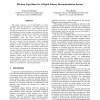108 search results - page 21 / 22 » The strength of non-size increasing computation |
UM
2005
Springer
13 years 11 months ago
2005
Springer
Abstract. Since problem solving in group problem-based learning is a collaborative process, modeling individuals and the group is necessary if we wish to develop an intelligent tut...
ISER
2004
Springer
13 years 11 months ago
2004
Springer
In October 2003, the first functional load-bearing and energetically autonomous exoskeleton, called the Berkeley Lower Extremity Exoskeleton (BLEEX) was demonstrated, walking at th...
INFOVIS
2003
IEEE
13 years 11 months ago
2003
IEEE
Network evolution is a ubiquitous phenomenon in a wide variety of complex systems. There is an increasing interest in statistically modeling the evolution of complex networks such...
ICPPW
2002
IEEE
13 years 10 months ago
2002
IEEE
generally meta-data, so that documents on any specific subject can be transparently retrieved. While quality control can in principle still rely on the traditional methods of peer-...
FC
1997
Springer
13 years 10 months ago
1997
Springer
Abstract. SPEED is a private key block cipher. It supports three variable parameters: (1) data length — the length of a plaintext/ciphertext of SPEED can be 64, 128 or 256 bits. ...


